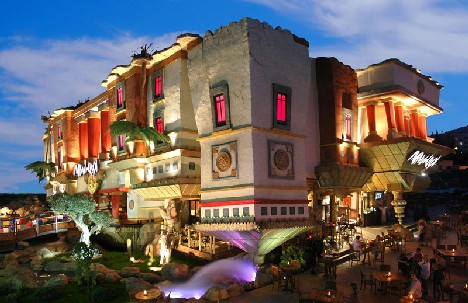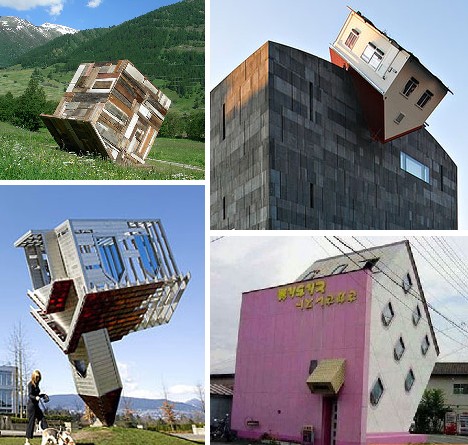
Upside down houses: they’re more common then you think… but why? Perhaps the artists and designers of these flipped out homes wanted to shake up the way we think of society’s most pressing need, shelter. Maybe they just wanted to stand out from the crowd. In that at least, they’ve succeeded.
Sakasa Restaurant, Japan
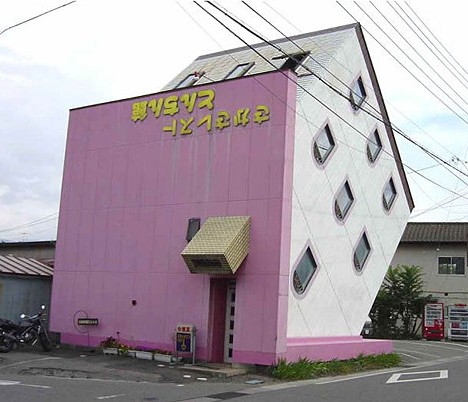 (image via: Nipponsoup)
(image via: Nipponsoup)
Real estate agencies just love the image of this upside down restaurant in Matsumoto city, Nagano prefecture, Japan – what better way to illustrate the philosophy of “house flipping”?
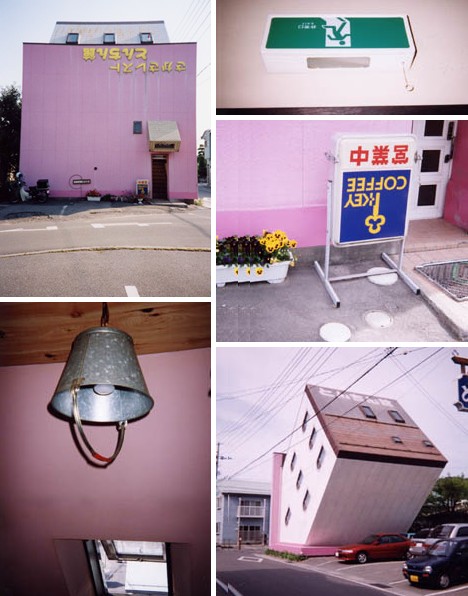 (images via: S66)
(images via: S66)
The designer of the upside-down restaurant went all out, inside and out, to fulfill his/her image of a world turned upside down: many of the ceiling light fixtures are inverted buckets, the outside advertising signboards and emergency exit signs are inverted and the menu displays mirror image text. No telling whether they serve reversal-of-fortune cookies after each meal.
Norman Johnson’s Upside-Down House, Florida, USA
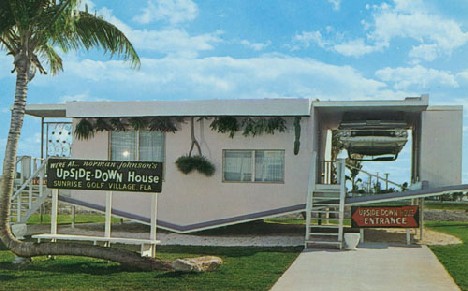 (image via: Lakaw)
(image via: Lakaw)
Want to see what the houses in Florida’s Sunrise Golf Village look like? Well, just stand – on your head – outside the model home above. Norman Johnson’s Upside-Down House is a faithfully transposed recreation of a typical home in lovely Sunrise, circa 1961. Even the furniture inside was mounted upside down, and that palm tree outside looks VERY confused.
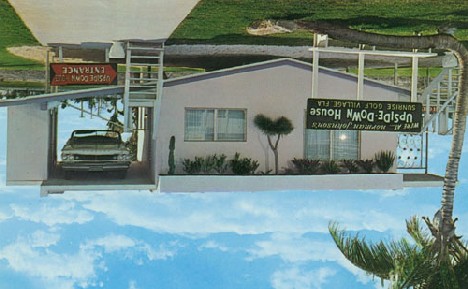 (image via: Florida View)
(image via: Florida View)
What appears to be a mid-1960s Dodge convertible is parked in the carport, or rather, on the carport’s ceiling. A good way to find loose change, to be sure. Sunrise, as it’s now called, was incorporated in 1961 by developer Norman Johnson and is located just west of Fort Lauderdale, Florida. The upside down model home did much to attract attention and homebuyers to embryonic Sunrise; sadly it’s been torn down… or is that “torn up”?
Device to Root Out Evil, Canada
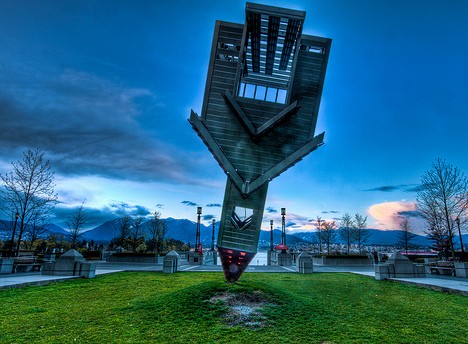 (image via: Chromatist)
(image via: Chromatist)
If church steeples are meant to point to heaven, where does THIS church look to for guidance and inspiration? Who the Hell knows?
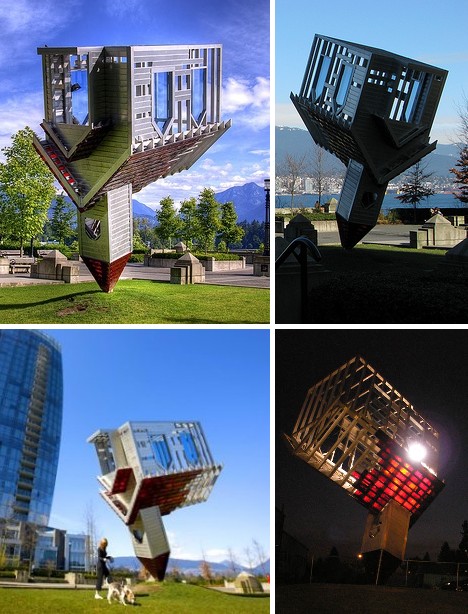 (images via: CultureKiosk, Beach United Church and 7 Deadly Sinners)
(images via: CultureKiosk, Beach United Church and 7 Deadly Sinners)
First installed in Vancouver, BC, Canada and later relocated to a park in Calgary, Alberta, the 25-ft tall, aluminum framed, red glass shingled “Device to Root Out Evil” was designed by American sculptor Dennis Oppenheim, who says that “Turning the church upside down makes it more aggressive, but not blasphemous.” Though commissioned by the President’s Panel on Art, the president of Stanford University rejected the sculpture because it was “not appropriate” for the campus.
Wonderworks, Florida & Tennessee, USA
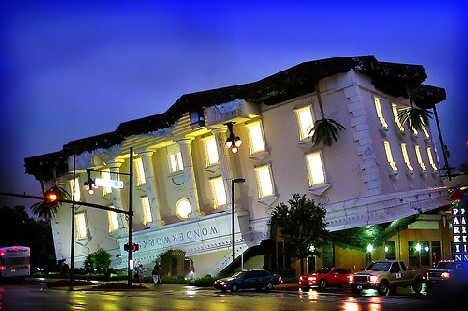 (image via: Boback)
(image via: Boback)
WonderWorks is “an amusement park for the mind” with 2 locations: Orlando, Florida, and Pigeon Forge, Tennessee. Both look from the outside like an oversized White House flipped onto its roof.
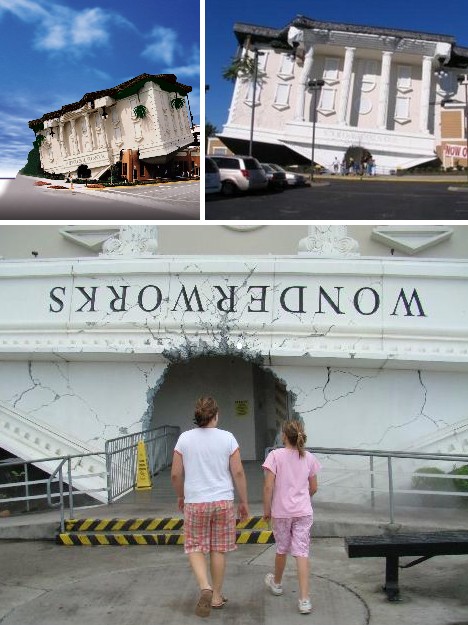 (images via: Smart Destinations, Reserve Pigeon Forge and Tripadvisor)
(images via: Smart Destinations, Reserve Pigeon Forge and Tripadvisor)
WonderWorks features over 100 interactive exhibits, a 12-seat movie theater equipped with motion seats and a 36-ft tall indoor ropes course. Why was it designed to look like an overturned building? They don’t say… one more thing for you to wonder about, it seems.
The World Stands on Its Head, Germany
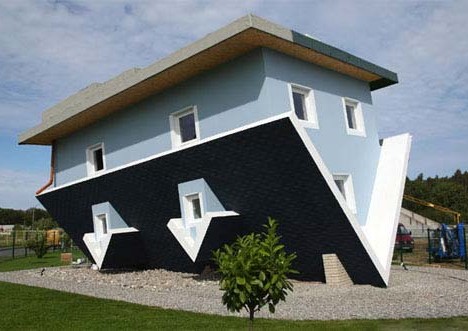 (image via: Urlesque)
(image via: Urlesque)
Opened to the public in the autumn of 2008, the “The World Stands on its Head” (“Die Welt Steht Kopf”) House can be found on the island of Usedom in the Baltic Sea. The house was designed by Klaudiusz Golos and Sebastian Mikiciuk, who carried the theme of upside down-ness to the inside as well.
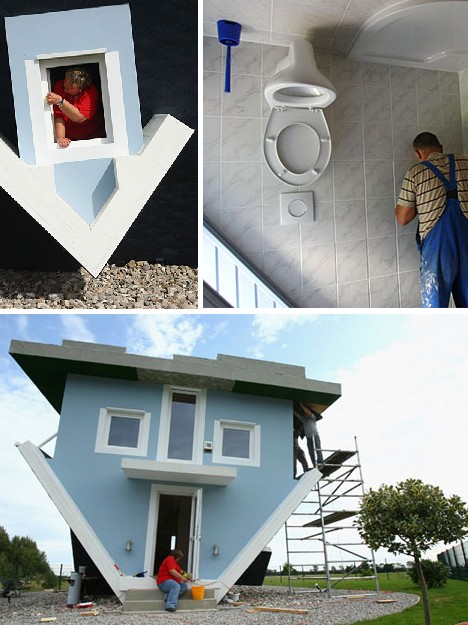 (images via: Zimbio)
(images via: Zimbio)
Tourists visiting the “The World Stands on its Head” would be well advised to take their bathroom breaks BEFORE entering the house. Though it may not appear so, the law of gravity works in the usual manner.
House Upside Down, Russia
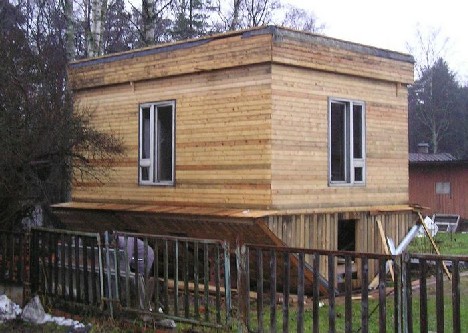 (image via: EnglishRussia)
(image via: EnglishRussia)
Putin on the ritz? There’s not much information is available to explain why a homeowner in St. Petersburg, Russia, built his home upside down. Perhaps he wanted to make a statement on the status of the Russian real estate market. Perhaps he was holding the blueprints upside down.
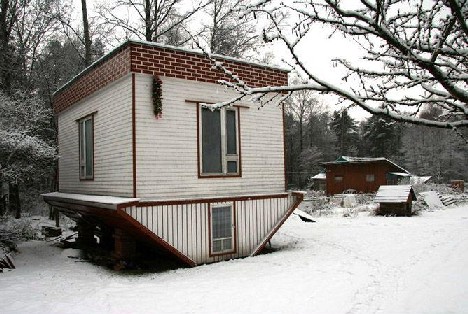 (image via: Ultrafunbd)
(image via: Ultrafunbd)
The image above shows the Russian upside-down house after completion. Note the decorative brickwork along the base, er, top of the walls. Note also the doghouse in the yard which was NOT built upside down – you Laika?
Upside-Down House, Poland
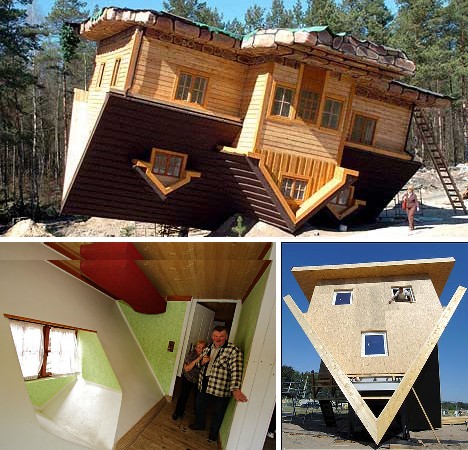 (images via: Design Spot Cool Stuff and The Sun UK)
(images via: Design Spot Cool Stuff and The Sun UK)
The Upside Down House in the tiny village of Szymbark, Poland, was built by Polish businessman and philanthropist Daniel Czapiewski. Unlike the anonymous Russian from St. Petersburg, Czapiewski hired a crew of carpenters and contractors who battled disorientation and dizziness to get the home completed in just 114 days.
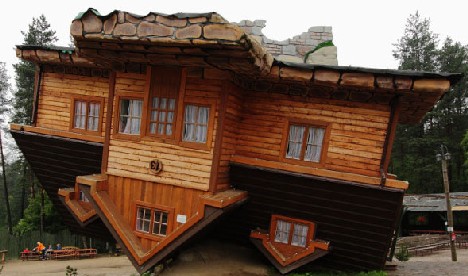 (image via: United Cats)
(image via: United Cats)
Czapiewski’s purpose in building the Upside Down House was to ridicule the Communist era and its many foibles and follies. Considering the state of capitalism lately and the subprime mortgage financial fiasco of 2008, maybe Czapiewski should build another upside-down house in the USA.
Turkish Upside Down House
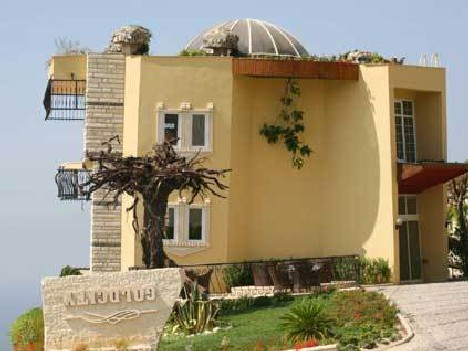 (image via: EnglishTurkey)
(image via: EnglishTurkey)
The Turkish Upside Down House in the city of Antalya was built as part of an effort to attract homebuyers to the area. They don’t call it the Goldcity Tourism Center for nothing! Obviously, some savvy Turkish entrepreneur took a page from Norman Johnson’s playbook. His cuning plan seems to be working as the house is said to be ” one of the most popular attractions for tourists in Antalya region.” Not sure what – if any – the other tourist attractions in the area are like.
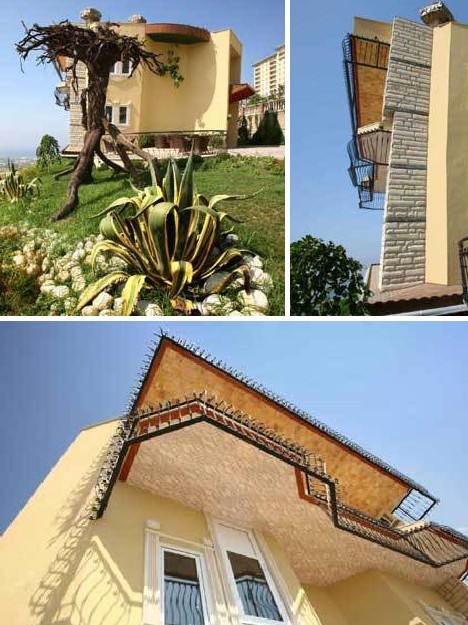 (images via: EnglishTurkey)
(images via: EnglishTurkey)
The Antalya house’s roof, windows, front door and balcony are all constructed upside down, as are the rooms (even the bathrooms) on the inside. Even the landscaping is upended – check out that tree in the front yard! Truly a supreme effort to turn one corner of the world upside down, but don’t ask why the Antalya upside-down house got the works; that’s nobody’s business but the Turks.
House-Attack, Austria
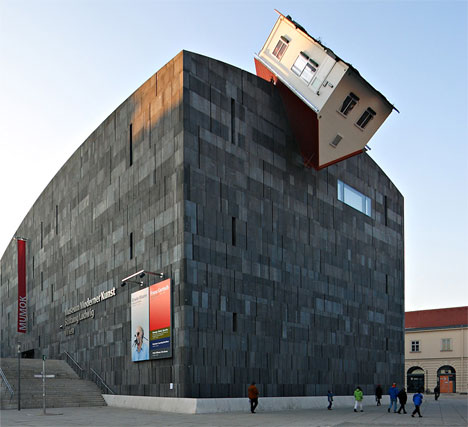 (image via: Ananova)
(image via: Ananova)
The House-Attack in Vienna, Austria is not for the sensitive of spirit – you know what happened the last time someone from Austria said “attack!” We’ll hope that this artistic installation by Erwin Wurm comes to a better (not bitter) end. The building/sculpture was constructed at Vienna’s Museum Moderner Kunst (MuMoK) in 2006. The artist explains the sculpture as follows: “A symbol for conservative, small-minded longings, the single-family house collides into the museum as an temple to the muses, and the museum itself now also becomes part of the sculpture.”
 (images via: The Letter, SBellen and Banitram)
(images via: The Letter, SBellen and Banitram)
That’s an actual house embedded in the museum’s roof, by the way – literally a “house attack”. Perhaps it wanted more lebensraum. In any case, watch this video to witness the rise (but not fall) of Wurm’s House-Attack:
House of Katmandu, Spain
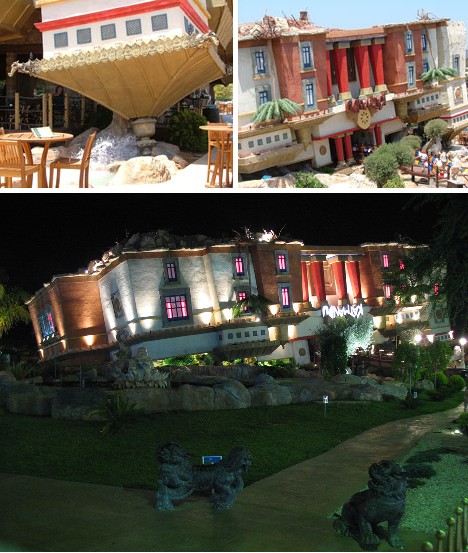 (images via: sider-oxydro and Enflecha2)
(images via: sider-oxydro and Enflecha2)
The House of Katmandu, opened in 2007, is a combination theme park, museum and tourist attraction located on the Spanish island of Majorca.
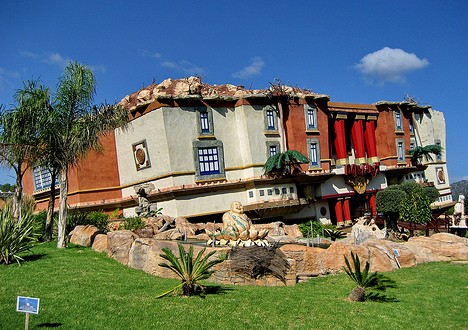 (image via: Odddutch)
(image via: Odddutch)
Designed to resemble a Tibetan-style mansion, the House of Katmandu takes visitors on a room-by-room adventure that follows the adventures of a fictional Indiana Jones-type character on a mysterious quest for a legendary red jewel. On the way he meets an ancient monk and a magnificent mermaid princess. Sorta like Star Wars meets Indiana Jones, in Spanish. In an upside-down house. Hey, you pay your money and you take your chances.
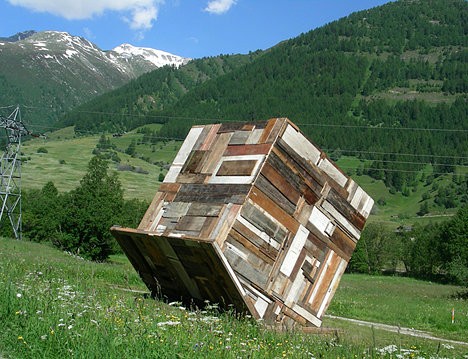 (image via: Nicole Chang)
(image via: Nicole Chang)
Gimme shelter… and some Gravol. These strange and unusual upside-down houses might be nice places to visit but you wouldn’t want to live there. Imagine waking up in the middle of the night, forgetting where you are… trying to find the bathroom would be the least of your problems.
